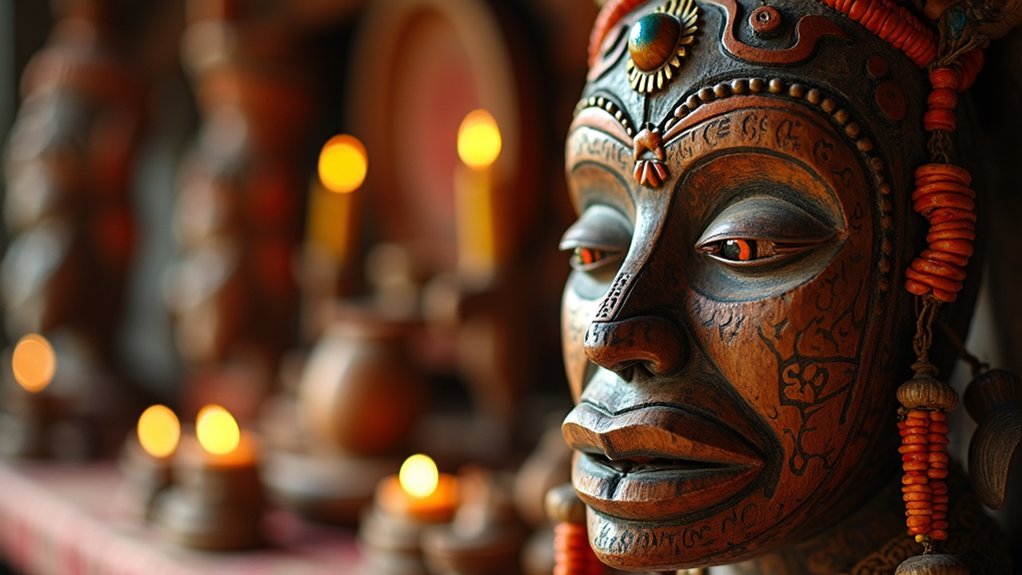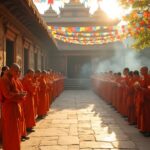
How did Byzantine culture and religion spread in Eastern Europe
Just how Byzantine culture and religion subtly transformed Eastern Europe reveals a fascinating blend of faith, politics, and innovation that shaped history.

In many African cultures, art is more than decoration—it’s a spiritual language. Masks, sculptures, and sacred objects carry deep meaning, connecting communities with ancestors, deities, and the unseen world.

But how exactly does art shape religious life, and what truths does it reveal about African spirituality?
Let’s take a closer look.
The role of masks in spiritual ceremonies is central to many African traditions. Across diverse cultures, these sacred objects act as bridges between the physical and spiritual worlds, helping participants connect with ancestors and divine forces.
In spiritual ceremonies, mask symbolism often reflects identity, morality, and community values, guiding people through rites of passage and sacred events. By enabling communication with spirits, offering protection, and strengthening social bonds, masks play a powerful role in religion and spirituality.
When used thoughtfully in spiritual ceremonies, they inspire respect for heritage and deepen communal faith.
Sculptures as representations of deities and ancestors play a powerful role in African spirituality. In many communities, these sacred sculptures act as bridges between the living and the spirit world, guiding rituals and honoring lineage.
As representations of deities and ancestors, they embody divine presence, invite protection, and help practitioners communicate with spiritual forces. These artworks also preserve cultural identity, sustain religious traditions, and deepen faith.
African textile art carries deep symbolism, with strong religious significance woven into every thread.
In many communities, African textile art uses motifs that act as spiritual symbols—signs of prayers, protection, and ancestral guidance. These patterns work like a visual language in sacred rituals, communicating beliefs, values, and collective memory.
Because of this, African textile art is not just decorative; it is a living expression of faith, spirituality, and cultural identity, helping people connect with the divine and honor their ancestors.
Body art in African cultures is more than decoration; it is closely connected to religion and spirituality.
In many communities, body modification practices like scarification and tattooing carry deep spiritual symbolism that communicates identity, status, and protection.
This sacred visual language acts as a bridge to ancestors and deities, reinforcing communal values, religious traditions, and spiritual beliefs.
Through body art, people express devotion, honor their heritage, and keep religion and spirituality at the heart of daily life.
Music and dance hold a profound place in the religious practices of many African cultures, complementing the symbolic significance of body art. In religion and spirituality, these forms serve as rhythmic expressions that invoke spiritual connection and emotional resonance.
Through communal participation, they strengthen social bonds and facilitate collective worship, making music and dance essential artistic expressions in religious ceremonies and rituals across diverse African communities.
Rooted in spirituality and tradition, these practices help believers connect with the divine, honor ancestors, and celebrate the living power of religion in everyday life.
Sacred spaces and their artistic decorations play a powerful role in African religion and spirituality. Across different cultures, sacred architecture features symbolic motifs and crafted materials that deepen spiritual presence and support community values.
These ritual spaces are intentionally designed and decorated to guide ceremonies, helping worshippers connect with the divine through meaningful artistic decorations.
Storytelling through visual art in African religious traditions plays a vital role in sharing spiritual wisdom and community values.
In many communities, artists use symbols, colors, and patterns to tell stories that reflect religion, spirituality, and ancestral guidance. These visual narratives highlight moral lessons, honor ancestors, and express spiritual beliefs, helping people connect with their roots.
By preserving sacred stories and cultural memory, storytelling through visual art in African religious traditions keeps religious knowledge alive and relevant for new generations.
As a result, storytelling through visual art in African religious traditions remains a powerful and accessible way to pass on faith, identity, and shared heritage.
Art in African cultures is deeply connected to religion, shaping how communities express spirituality and honor their beliefs. In many traditions, masks, sculptures, textiles, body art, music, dance, and sacred spaces are used to connect with ancestors and the divine, making religion a living, daily experience. These creative practices guide rituals, mark life transitions, and protect communities, showing how spirituality and culture are inseparable. By preserving stories, values, and sacred knowledge, religious art strengthens identity and social bonds. In this way, African religious art reveals how religion, spirituality, and culture work together across generations, keeping faith practices meaningful and alive.

Just how Byzantine culture and religion subtly transformed Eastern Europe reveals a fascinating blend of faith, politics, and innovation that shaped history.

What mysteries did Olmec and Mayan religions unlock about life, power, and the cosmos? Their beliefs shaped civilizations in ways still felt today.

Linking sacred numbers to celestial events, the Maya intertwined math and religion in ways that still mystify scholars today. Discover their profound connection.

Only by examining religion can we grasp the deep values shaping cultures—discover how belief systems influence identity and social cohesion.

The transformative impact of culture on Buddhist practices reveals unexpected variations that challenge traditional interpretations and invite deeper exploration.

Journey into how religion and mythology shaped every facet of Greek life, revealing secrets that still captivate and influence us today.